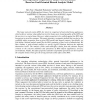149
click to vote
BIRTHDAY
2004
Springer
15 years 6 months ago
2004
Springer
CSP was originally introduced as a parallel programming language in which sequential imperative processes execute concurrently and communicate by synchronized input and output. The...
130
click to vote
SAS
2005
Springer
15 years 6 months ago
2005
Springer
There are many source-level analyses or instrumentation tools that enforce various safety properties. In this paper we present an infrastructure that can be used to check independe...
94
Voted
ESORICS
2005
Springer
15 years 6 months ago
2005
Springer
We consider the enforcement powers of program monitors, which intercept security-sensitive actions of a target application at run time and take remedial steps whenever the target a...
MEMOCODE
2005
IEEE
15 years 6 months ago
2005
IEEE
In principle, bounded model checking (BMC) leads to semidecision procedures that can be used to verify liveness properties and to falsify safety properties. If the procedures fail...
ICDCSW
2005
IEEE
15 years 6 months ago
2005
IEEE
Although a self-stabilizing system that suffers from a transient fault is guaranteed to converge to a legitimate state after a finite number of steps, the convergence can be slow ...
IPPS
2006
IEEE
15 years 7 months ago
2006
IEEE
Violations of a number of common safety properties of multithreaded programs–such as atomicity and absence of dataraces–cannot be observed by looking at the linear execution t...
FMCAD
2007
Springer
15 years 7 months ago
2007
Springer
— Induction has been studied in model checking for proving the validity of safety properties, i.e., showing the absence of counterexamples. To our knowledge, induction has not be...
CAV
2007
Springer
15 years 7 months ago
2007
Springer
We present Hector, a software tool for combining different abstraction methods to extract sound models of heap-manipulating imperative programs with recursion. Extracted models ma...
106
click to vote
FGCN
2008
IEEE
15 years 7 months ago
2008
IEEE
The home network system (HNS, for short) is comprised of networked home appliances, which achieves various value-added services for home users. Assuring safety of the HNS and the ...
101
click to vote
HICSS
2009
IEEE
15 years 7 months ago
2009
IEEE
Deeply embedded infrastructures are pervasive systems that have significant cyber and physical components, interacting with each other in complex ways. These interactions can vio...

